The earliest human ancestors (Homo erectus and Homo habilis) have their origin in East Africa more than 2 million years ago. Several human remains have been found in Kenya and neighbouring countries. The Khoisan were the first modern people known to inhabit East Africa. They are followed by Cushitic people (from north), Bantu speaking groups (from Central Africa), Nilotes (from Sudan) as well as Oromo and Somali people (from Ethiopia). Evidence suggests that in the Late Stone Age (3000BCE to 1000BCE) peoples from Ethiopia arrived in Kenya around 2000BCE, and again in 1000BCE, to occupy most of the area of the country. Around 400CE Bantu-speaking peoples arrived in the country, followed by further waves of Bantu peoples such as the Gusii, Kikuyu, Akamba and Meru from West Africa.
5th Century to 15th Century
Arabs begin to settle in coastal areas, eventually developing trading centres that facilitated contact with the Arab world, Persia and India. Trade in ivory, rhino horn, gold, shells and enslaved people transform Mombasa, Malindi and the Islands of Lamu and Pate into important centres of trade. African groups on the coast gradually develop the Swahili culture with Islam as their religion. The Swahili language slowly forms as a result of Arab influence, combining Bantu with elements of Arabic.
1498
Vasco da Gama, a Portuguese explorer, reaches East Africa with ships and firearms. The Portuguese are eager to control trade around the Indian Ocean. )
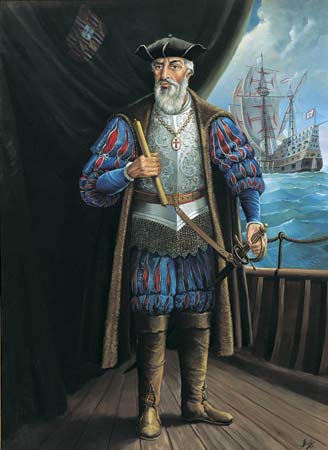 Vasco da Gama. Image source
Vasco da Gama. Image source
16th century
The Portuguese try to establish a foothold on the Kenyan coast, but by the late 17th century they are driven off by Swahili city states and Omani Arabs.
1505
The Portuguese wage war against cities on the East Coast in their attempt to control the region. Dom Francisco de Almeida arrives with 23 ships and about 1,500 soldiers. Mombasa is bombed and the occupied by Portuguese troops. Over the next 200 years the Arabs fight against the Portuguese for control of the region.
1585 and 1589
The Ottoman Turks attempt to regain control of the Kenyan Coast, but are defeated by the Portuguese. In a brutal colonial campaign, the Portuguese try to convert people into Catholics, but Islam has become dominant along the east coast.
1593
Mombasa becomes the centre of Portuguese power. Fort Jesus is established in Mombasa harbour to defend the city from seaborne attacks and also from increasing Swahili resistance.
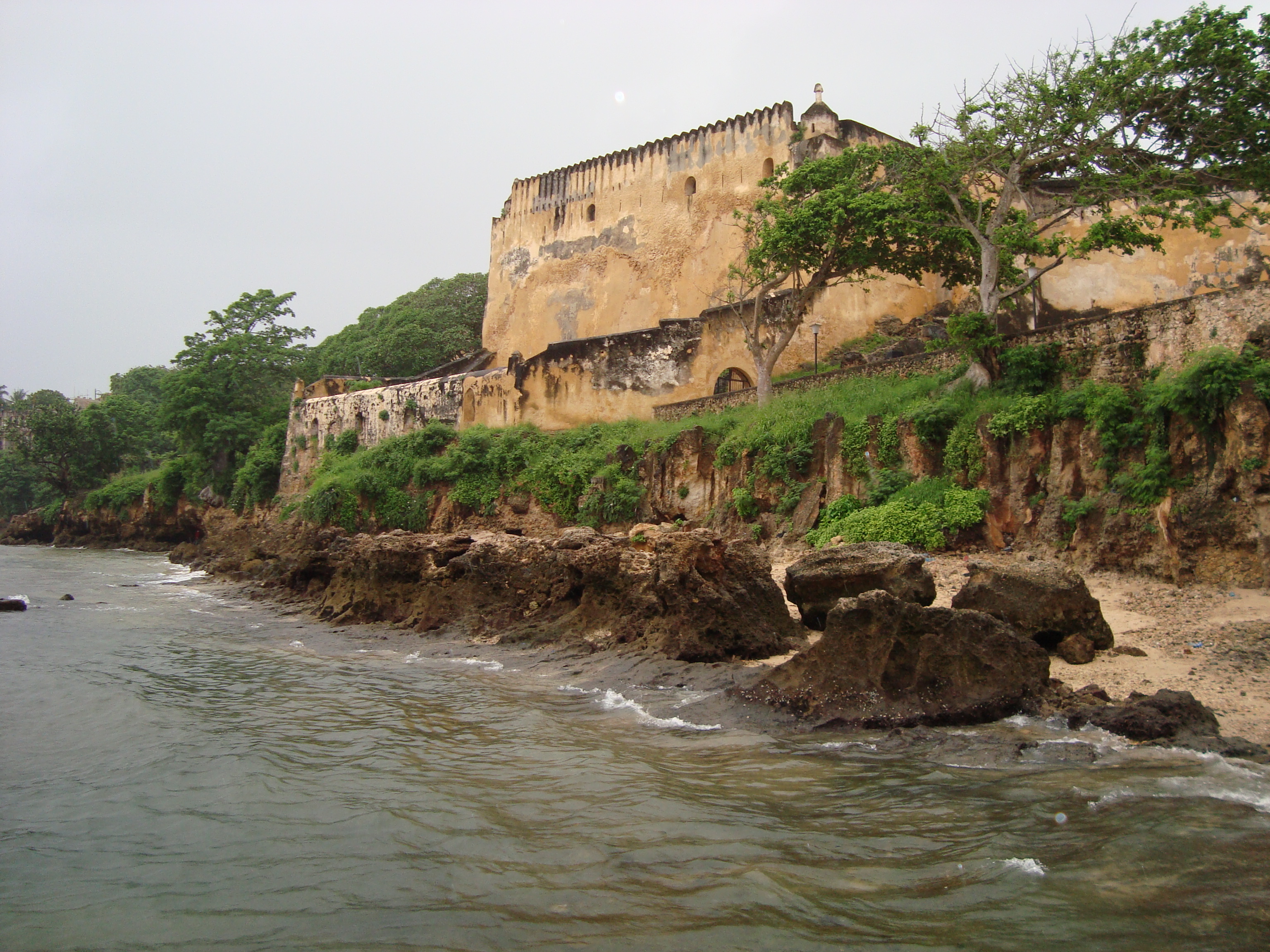 The remains of Fort Jesus in Mombasa. Image source
The remains of Fort Jesus in Mombasa. Image source
1698
After 33 months of siege, Fort Jesus and Mombasa are taken by the Arabs. Arab sultans conquer most of the East African coast, forcing the Portuguese to leave the region.
1822
The Sultan of Oman Sayyid Said sends an army to East Africa, claiming control of Swahili dynasties along the coast. Swahili clans resist and ask Britain for help. Two warships are sent from Britain and the captain declares the Mombasa region as a British protectorate, which lasts for about three years.
1832
The Sultan of Oman moves with his court to Zanzibar. He establishes plantations to grow cloves and develops trade routes deep into Africa. Spice production and export of Ivory and slaves become the basis of his empire.
1847
European missionaries begin travelling west and exploring the interior of Kenya. German explorers Krapf and Rebmann are the first to reach Taita Hills, and report seeing Mount Kilimanjaro and Mount Kenya.
1873
David Livingstone dies in Central Africa. His body is carried on a month-long journey to Zanzibar.
1877
The Sultan of Oman offers the British East Africa Company a concession to administer East Africa. The British completely negotiate only with the Sultan, excluding the Swahili population, and take Zanzibar.
1886
The European colonial powers divide Africa between themselves at the Berlin Conference, beginning the scramble for Africa. Germany and Britain are dominant in East Africa. The Sultan of Oman is granted a strip on the coastline.
1895
British East African Protectorate formed.
1898
The construction of a railway from Mombasa to Lake Victoria progresses fast, but is delayed in Tsavo. Two lions kill 135 Indian and African railway workers. Lt. Col. J.H. Patterson kills the lions after hunting them for nine months.
 Construction of the Kenyan railway. Image source
Construction of the Kenyan railway. Image source
1899
The city of Nairobi is founded.
1901
The railway from Mombasa to Kisumu is completed, spanning 965 km. European and Indian settlers arrive in great numbers in East Africa. White settlers control the colony and take the most fertile land while the African inhabitants are forced into ‘native reserves’. In the following years several local uprisings are suppressed by British soldiers.
1902
The border between Kenya and Uganda is established, making Kisumu and the area around Lake Victoria part of Kenya.
1905
British settlers begin their first experiments growing coffee in Kenya.
1907
The British colonial administration moves from Mombasa to Nairobi.
1910
Nairobi becomes the official capital of Kenya.
1914
World War I begins to affect Africa. 47,000 Kenyan Africans volunteer for service.
1915
The British settlers take 5,186 hectares from the Africans, and the Crown Lands Ordinance Act further reduces native land rights. All African adult males are required to carry identification papers when leaving the reserves.
1918
World War I ends and an influx of European settlers, many of whom are ex-soldiers, exacerbates the crisis surrounding land ownership in Kenya.
1921
The East African Protectorate becomes the crown colony of Kenya, administered by a British governor. The East African Association (EAA), one of the first organisations to campaign for African rights in the region, is formed by Harry Thuku, and, among others, Jomo Kenyatta.
1922
Africans educated at the Missions begin protesting against British policies. The EAA is banned and Thuku arrested.
1923
The first tea plantation is founded in Kenya. A law ensures that only the European settlers profit from the export of tea and coffee.
1924
The Kikuyu Central Association (KCA) is formed to continue the work of the EAA.
1939
Labour unions begin to organise in the colony and many go on strike in Mombasa. The outbreak of the Second World War results in the recruitment of around 100,000 Kenyans to fight against the Italians in East Africa.
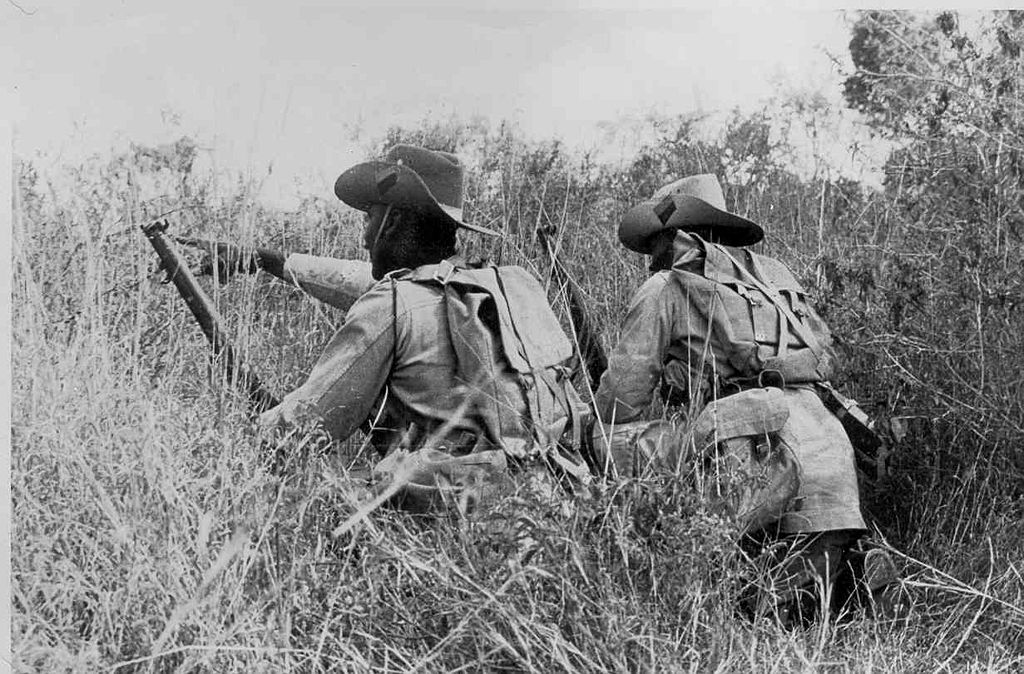 Kenyan soldiers training during the Second World War. Image source
Kenyan soldiers training during the Second World War. Image source
1940
The KCA is banned.
1942
The Kenyan African Union (KAU) is formed to push for independence. This is the first African appointment to the legislative council.
1947
Jomo Kenyatta becomes leader of KAU.
1952
A political Kikuyu grouping calling themselves the Mau Mau begins to mount violent attacks against white settlers. Mau Mau guerrillas organize themselves as the Kenya Land Freedom Army (KFLA). As the rebellion continues Britain declares a state of emergency in Kenya. Jomo Kenyatta, mistakenly regarded as the leader of the Mau Mau, is jailed and the KAU is banned.
February 6, 1952 – The future queen of England, Elizabeth, is visiting Kenya when her father, King George VI, dies of cancer. She returns to England as Queen Elizabeth II.
1953-55
Mau Mau warriors kill Africans loyal to the British and target some Europeans. Around 50,000 British soldiers are sent to suppress the rebellion, using bombers to attack Mau Mau strongholds. The government begins a policy of transporting Kikuyu to reserves and imprisons suspected Mau Mau supporters in concentration camps, where human rights abuse and torture are commonplace.
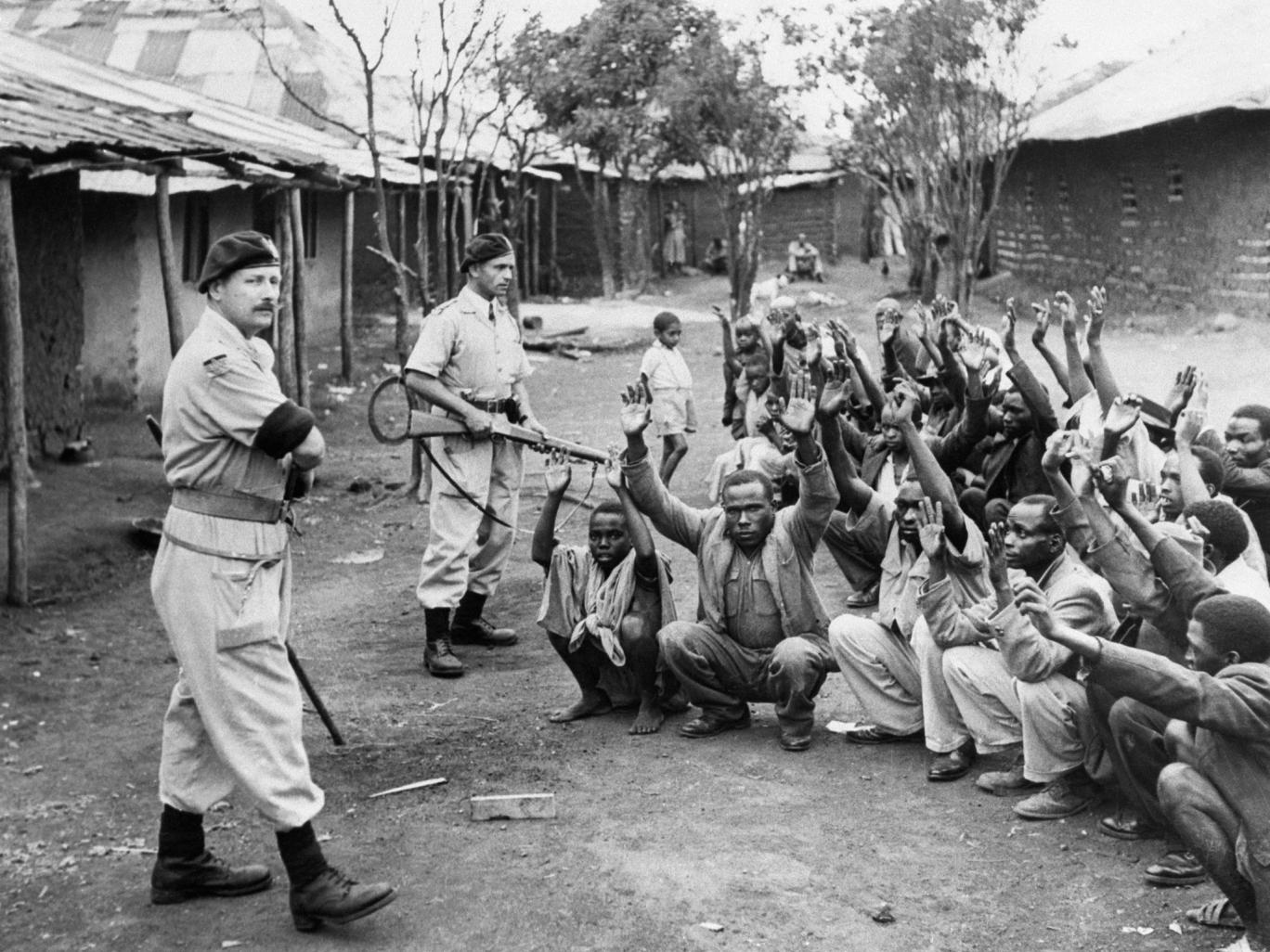 British police detain Kenyans suspected of Mau Mau involvement. Image source
British police detain Kenyans suspected of Mau Mau involvement. Image source
1956
The leader of KLFA, general Dedan Kimathi, is captured by British troops with assistance from a loyal Kikuyu group. Without effective leadership, the Mau Mau is defeated. Government estimates claim that 11,503 Mau Mau have been killed – although the number was likely much higher – in comparison to 30 Europeans. About 100,000 African people are imprisoned.
1957
Kimathi is executed. Ghana becomes the first African colony to gain independence. An official British government analysis estimates that Britain spends £51 million on its colonies every year.
1958
Hayes and Tebbutt launch the weekly Taifa (‘Nation’) with a commitment to supporting independence ‘in a reasoned way’. Its first headline was a quote from a Tom Mboya speech at a political meeting in Kaloleni: ‘When shall we see freedom?’ The paper is soon sold to the Nation Media Group, which changes the title to Nation.
1959
Kenyatta is transferred from prison to house arrest. The formation of political parties is no longer illegal and African politicians are invited to attend negotiations in London. The Hola Camp massacre sees 11 Mau Mau prisoners die of ill-treatment.
1960
The state of emergency is lifted and talks are held at Lancaster House in London to discuss Kenyan independence. Colonial Secretary Iain Macleod acknowledges the inevitability of Kenyan independence and the British government starts preparing the country for a transition to independence.
May – the KAU is renamed as the Kenya African National Union (KANU) party, formed by Tom Mboya and Oginga Odinga. Kenyatta is elected president in absentia.
June – Politicians fearful of Kikuyu-Luo domination form Kenyan African Democratic Union (KADU), which favours a federalist government. Ronald Ngala becomes president, Masinde Muliro VP and Daniel arap Moi chairman.
October – First issue of the Daily Nation hits the streets and becomes the first national daily newspaper in Kenya.
1961
February – KANU wins the first general election under the new constitutional dispensation, taking 16 seats in the 53-member Legco to KADU’s ten, but refuses to form a government until Kenyatta is released. KADU forms a coalition government with the white-led New Kenya Party.
March – Kenyatta is moved from restriction in Lodwar to a halfway house at Maralal, where the press sees him for the first time in nine years. Five months later he is released and returns to his Gatundu home. He becomes leader of the Kenya African National Union (KANU).
1963
Kenya gains independence, with Kenyatta as prime minister. Prince Philip accepts an invitation to preside over the lowering of the Union Jack and the raising of the Kenyan flag at a ceremony on 12 December 1963, attended by thousands of celebrating Kenyans.
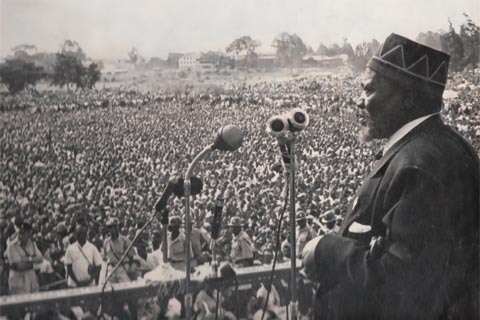 Jomo Kenyatta addresses crowds celebrating independence. Image source
Jomo Kenyatta addresses crowds celebrating independence. Image source
1964
The Republic of Kenya is formed with Kenyatta as president and Oginga Odinga as vice president. The party KADU dissolves and integrates with KANU, leaving the government without official opposition and effectively creating a one-party state. Fearing what will happen after independence, as many as 10,000 whites leave the country.
1965
February 24 – The death of Goan socialist Pinto comes as the first of several subsequent political assassinations, including Tom Mboya, J.M. Kariuku and Robert Ouko.
1966
Odinga, a Luo, leaves the Kikuyu-dominated KANU after an ideological split, to form the rival Kenya People’s Union (KPU). He is arrested several times over the next few years. The Preservation of Public Security Bill of 1966 provides for detention without trial and other special measures under emergency powers granted to the President to combat threats to national security.
1969
The assassination of government minister Tom Mboya, a Luo, by a Kikuyu, sparks ethnic unrest. KPU is banned and Odinga arrested. KANU becomes the only political party to contest elections as conflicts between ethnic groups continue.
1974
Kenyatta re-elected as president. Kiswahili becomes the official language in parliament.
1976
Border problems and regional tensions arise as Ugandan dictator Idi Amin claims huge parts of Kenya and Sudan.
September 27 – The front page of the Standard newspaper reports on a demand by a group of MPs and cabinet ministers at a rally in Nakuru: they want Kenya’s constitution changed to prevent the vice president from automatically assuming the presidency when that office becomes vacant, with elections within 90 days. The move is seen as an attempt by the dominant Gatundu grouping, the circle around President Kenyatta, to keep power from passing from their ethnic circle.
1977
Big game hunting is prohibited by law.
1978
August 22, 1978 – Jomo Kenyatta dies at his home in Mombasa.
October 6, 1978 –Daniel arap Moi, Vice President under Kenyatta, becomes president of Kenya. The new national slogan launched by Moi is ‘Nyayo’, meaning follow the tracks. Moi bans tribal societies and closes down universities, engaging with armed force and imprisoning people.
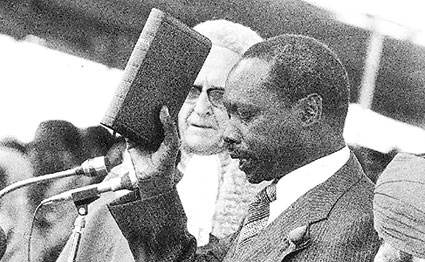 Daniel arap Moi takes office as Kenya’s second president. Image source
Daniel arap Moi takes office as Kenya’s second president. Image source
1979
Moi launches a plan for the protection of rhinos in Kenya.
1982
The Republic of Kenya is officially declared a one-party state by the ruling KANU party. Members of the Kenyan air force launch a failed military coup in which 120 people are killed. Forces loyal to the government put an end to the rebellion. Twelve people are sentenced to death and 900 are jailed.
1987
President Moi is re-elected after introducing a complicated and highly criticised voting system. Opposition leaders including Kenneth Matiba are jailed without trial.
1989
Political prisoners are freed. President Moi burns 12 tons of ivory, making a public statement against poaching.
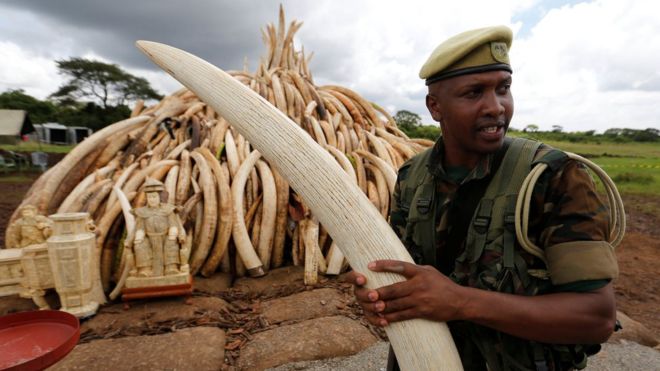 President Moi burning ivory. Image source
President Moi burning ivory. Image source
1990
Communist regimes in Eastern Europe collapse, bringing an end to the Cold War. Western donor countries put pressure on the Kenyan government to democratize and introduce multiparty systems. KANU Youth groups begin to harass opposition members, provoke riots during demonstrations and stoke ethnic clashes.
1990
July 7 –An illegal demonstration, which becomes known as the ‘Saba Saba’ (Seven Seven – the date in Swahili), is put down by police and the military. Twenty demonstrators are killed and several hundred arrested, including politicians, human rights activists and journalists. The objective of the protest is free and fair elections.
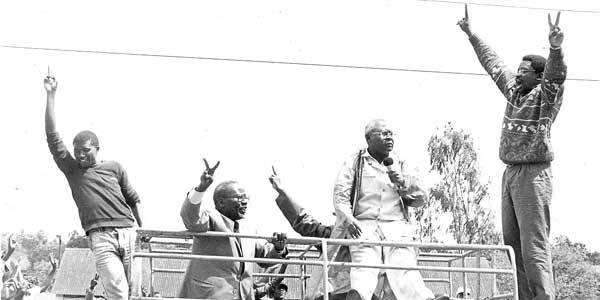 Saba Saba protestors demanding political reform. Image source
Saba Saba protestors demanding political reform. Image source
Death of the Minister of Foreign Affairs and International Co-operation, Dr. Robert Ouko, in suspicious circumstances leads to increasing opposition against government.
1991
Six opposition leaders, including Oginga Odinga, form the Forum for the Restoration of Democracy (FORD).
The party is banned and its members arrested. Creditors suspend aid to Kenya amid fierce international condemnation.
Most Western countries suspend their economic aid to Kenya in condemnation of the political oppression and abuses of human rights. Moi finally gives in and introduces a multi-party system in Kenya. The constitution is changed, allowing registration of opposition parties for the first time.
1992
As elections loom, 2,000 are killed in ethnic clashes in the Rift Valley region. Some observers accuse KANU of provoking the violence. President Moi puts an end to the conflict and presents himself as a peacemaker.
FORD splits into two factions: FORD-Asili (led by ex-government minister Kenneth Matiba) and FORD-Kenya (led by Odinga).
December 29 –Moi is re-elected as President in Kenya's first multiparty election. Some foreign observers report widespread instances of vote tampering.
1993
International donors, the IMF and the World Bank force the government to begin economic reforms in Kenya.
1994
January 20 – Oginga Odinga dies. The opposition parties form a new coalition, the United National Democratic Alliance (UNDA), but are divided by internal disputes.
1995
Palaeontologist Richard Leakey launches a new opposition party – ‘Safina’ – but the party is refused official registration until November as Moi argues strongly against having White men in government.
1996
KANU announces that the constitution will be changed to allow Moi to stay in office for another term.
1997
Demonstrations call for democratic reform. The World Bank withholds disbursement of $5 billion in structural adjustment credit.
August 14 – 200 raiders attack a police station in Likoni, Mombasa. Prisoners are freed, while six police officers and seven civilians are killed. The group seize rifles and ammunition .Massacres and ethnic violence grip the coastal area.
1997
The El Nino climatic condition causes floods to the Kenyan coast. Several thousand are left homeless.
December – Moi wins a fifth term in widely criticized elections also fought by former vice president Mwai Kibaki and Raila Odinga, son of Oginga Odinga.
1998
August – 224 people are killed when a bomb explodes in Nairobi's US embassy. The bombing is later linked to Osama Bin-Laden and the Al-Qaeda terrorist network, along with simultaneous attacks in neighbouring Tanzania.
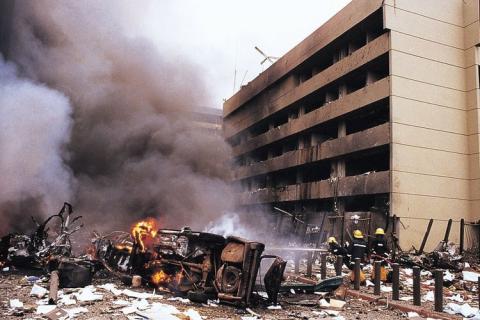 Aftermath of the attack on the US embassy in Nairobi. Image source
Aftermath of the attack on the US embassy in Nairobi. Image source
Kenya, Uganda and Tanzania form a new East African Community.
1999
Moi appoints Richard Leakey to head a government drive against corruption. Leakey becomes a minister in the KANU government.
2000
A severe drought causes food shortages in Northwest Kenya.
2001
Leakey appears in court to face charges of abuse of power and perverting the course of justice.
June 11 – Moi reshuffles cabinet and appoints opposition party leader Raila Odinga as energy minister in the first coalition government in Kenya’s history.
August – 3 million people starve as Northern Kenya suffers from drought.
Several anti-corruption initiatives are announced to placate the IMF. The anti-corruption bill is defeated by parliament.
October – Uhuru Kenyatta (son of Jomo Kenyatta) is appointed to parliament and given a cabinet post by President Moi.
December – Riots over rents in Kibera, Nairobi's huge informal settlement, cause thousands to flee the city. Several people are killed.
2002
July – A number of opposition parties form the National Alliance Party of Kenya to battle KANU in forthcoming general elections.
August – Moi fires his vice-president, George Saitoti, in an apparent attempt to weaken his opposition within KANU.
December – NARC presidential candidate Mwai Kibaki wins a landslide victory in general elections, ending Daniel arap Moi’s 24-year rule and KANU’s four decades in power.
2003
January – A government bill proposes an anti-corruption commission. John Githongo, a critic of Moi, is appointed anti-graft boss.
November – The International Monetary Fund (IMF) resumes lending to Kenya after a three-year gap, citing anti-corruption measures.
December – The government decides to grant former president Daniel arap Moi immunity from prosecution on corruption charges.
2004
March-July – The long-awaited draft of a new constitution is completed. The document has to be approved by parliament and proposes curbing the president’s powers and creating the post of prime minister. The deadline for enactment is missed.
July-August – A food crisis caused by crop failures and drought, is described as a ‘national disaster’ by President Kibaki. The UN launches an aid appeal for vulnerable rural Kenyans.
December 10th – Wangari Maathai, a minister in the Kenyan government and the founder of the Green Belt Movement, receives the Nobel Peace Prize in Oslo. She is the first African woman to receive this prize.
2005
January – Clashes over land and water rights leave more than 40 people dead.
February – Reports allege that corruption has cost Kenya $1-billion under Kibaki’s presidency. Leading anti-graft official John Githongo resigns as international donors express unease.
July – Parliament approves a draft constitution after days of violent protests in Nairobi over aspects of the draft, which demonstrators say leaves too much power in the president’s hands.
November-December – Voters reject the proposed new constitution in what is seen as a protest against President Kibaki. The president replaces his cabinet, but some nominees reject their appointments.
2006
January – the government declares that four million people in the north need food aid because of a drought, which the president labels a ‘national disaster’.
January-February – A corruption scandal involving contracts for a phantom company sees government ministers accused. One of them, Finance Minister David Mwiraria, resigns and says the allegations against him are false.
March – Government orders armed police to raid the offices and presses of one of Kenya’s leading media companies, the Standard group.
April - Visiting Chinese President Hu Jintao signs a contract allowing China to prospect for oil off the Kenyan coast. His African tour has focused on securing energy and raw materials for his country.
October – The UN says some 35,000 Somalis escaping drought, Islamist rule and looming conflict have arrived in Kenyan camps since early 2006.
October-December – Thousands become homeless after heavy flooding in the region. About 100,000 Somali refugees cut off by floodwaters in the North-East are supplied by air drops.
2007
May – A Kenya Airways plane crashes in Cameroon, killing all 114 on board. An official investigation blames pilot error.
December – Disputed presidential elections lead to violence in which more than 1,500 die. President Kibaki claims victory in presidential elections, gaining a second term in office. Opposition parties and international agencies suggest election results were manipulated. The Orange Democratic Movement (ODM) wins a majority in parliament.
Post-election violence erupts throughout Kenya amid calls for an international tribunal to try those implicated in the conflict.
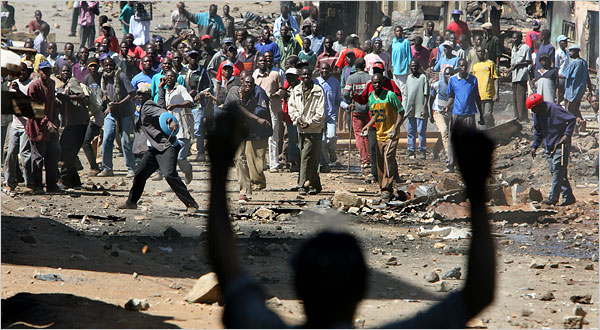 Ethnic violence spread following the disputed 2007 elections. Image source
Ethnic violence spread following the disputed 2007 elections. Image source
2008
February – The government and opposition come to a power-sharing agreement. Former UN Secretary-General Kofi Annan brokers talks between President Kibaki and opposition leader Raila Odinga.
April – Kenya's largest government cabinet, with 40 seats, is agreed by Kibaki and Odinga.
October – A report into post-election clashes calls for an international tribunal to try those implicated in violence. Many political leaders are reluctant to implement the commission of inquiry's recommendations, with some arguing that prosecutions could trigger further clashes between communities.
December – The Kenya Anti-Corruption Commission (KACC) accuses seven current and former MPs of taking illegal allowances worth $250,000.
2009
August – Visiting US Secretary of State Hillary Clinton criticises Kenya for failing to investigate the deadly violence after the 2007 election.
The government says that at least 10 million people, or one third of the population, are in need of food aid, and mobilises the military to distribute food, water and medicines to areas hardest hit by drought.
October – The government says it will co-operate with the International Criminal Court (ICC) to try key suspects in post-election violence.
2010
January – The US suspends $7-million in funding for free primary schools in Kenya until fraud allegations have been investigated.
February – President Kibaki overturns a decision by Prime Minister Odinga to suspend the country's agriculture and education ministers over alleged corruption. The row threatens the coalition government.
July – Kenya joins its neighbours in forming a new East African Common Market, intended to integrate the region's economy.
August – A new constitution designed to limit the powers of the president and devolve power to the regions is approved in a referendum.
2011
April – A truth commission begins a public probe into 3,000 killings at Wagalla airstrip that occurred during a 1984 crackdown on ethnic Somalis.
Six politicians appear before the International Criminal Court in The Hague, accused of links to the 2007-8 post-election violence.
June-September – East Africa hit by its worst drought in 60 years.
August-September – Suspected Somali militants raid Kenyan coastal resorts and a refugee camp, targeting foreigners.
October – Kenyan troops enter Somalia to attack rebels they accuse of being behind several kidnappings of foreigners on Kenyan soil. Kenya suffers several apparent reprisal attacks.
November – The High court orders the arrest of Sudanese President Omar al-Bashir if ever he visits Kenya. Sudan orders Kenya's ambassador to return to his country.
2012
January – The International Criminal Court rules that several prominent Kenyans must stand trial over the 2007 post-election violence.
May – More than 30 people are injured in an attack on a Nairobi shopping centre, allegedly by Somalia's Al-Shabaab Islamist militia.
June – Internal Security Minister George Saitoti is killed in a helicopter crash.
July – Fifteen people are killed in an attack on two churches in Garissa, near the Somali border. Al-Shabaab is again the prime suspect.
August-September – More than 100 people are killed in communal clashes over land and resources in the Coast Province. Junior minister Dhadho Godhana is charged with incitement. He denies the charge.
Five people die in riots by Muslim protesters in Mombasa after the shooting of preacher Aboud Rogo Mohammed, accused by the UN of recruiting and funding Al-Shabaab Islamist fighters in Somalia. Muslim cleric Abubaker Ahmed is charged with inciting the protests.
September - Junior minister Ferdinand Waititu is charged with hate speech and incitement to violence over anti-Maasai remarks caught on video tape and made in response to the reported killing of a child by a Maasai security guard.
November – Troops rampage in the town of Garissa, near the Somali border, after gunmen shoot dead three Kenyan soldiers serving in the African Union mission in Somalia.
December – Deputy PM Uhuru Kenyatta and former minister William Ruto – bitter political rivals facing trial at the International Criminal Court over the 2007 post-election violence – confirm that they are forming an alliance for the 2013 election.
2013
March – Uhuru Kenyatta, the son of Kenya’s first president, wins presidential election with just over 50% of the vote. The Supreme Court rejects a challenge to the results by his main rival, Prime Minister Raila Odinga.
The International Criminal Court (ICC) drops charges against Francis Muthaura, a co-accused of Mr Kenyatta, over the 2007 election violence.
June – For the first time, the British government acknowledges its colonial administration tortured thousands of detainees during the suppression Mau Mau uprising and apologises to the survivors.£20million in compensation is promised.
September – Deputy President William Ruto pleads not guilty to crimes against humanity charges at the International Criminal Court. He and President Uhuru Kenyatta are accused of orchestrating violence after elections in 2007, and will be tried separately at The Hague.
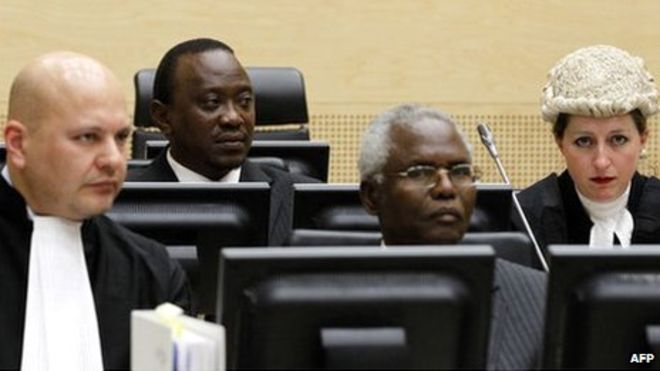 Uhuru Kenyatta and Francis Muthaura at the International Criminal Court. Image source
Uhuru Kenyatta and Francis Muthaura at the International Criminal Court. Image source
Somali Al-Shabaab militants seize a Nairobi shopping mall and kill 67 people, declaring their motivation to be retaliation for Kenyan military involvement in Somalia.
October – Radical Muslim cleric Sheikh Ibrahim Rogo killed by gunmen in Mombasa. Supporters allege the security forces killed him.
2014
May – Several countries issue travel warnings following several attacks over recent months blamed on Somali Al-Shabaab militants.
June – 48 people die after Islamist militants attack hotels and a police station in Mpeketoni, near the island resort of Lamu.
President Kenyatta appears before the International Criminal Court (ICC), where he faces charges of crimes against humanity over the 2007 election violence.
October – 40,000 Kenyans, alleging human rights abuse suffered during the suppression of the Mau Mau uprising, begin a litigation suit against the UK government.
December – The ICC withdraws charges against Kenyatta, accusing the government of refusing to hand over important evidence.
2015
Gunmen aligned with Al-Shabaab attack Garissa University, killing 148 people.
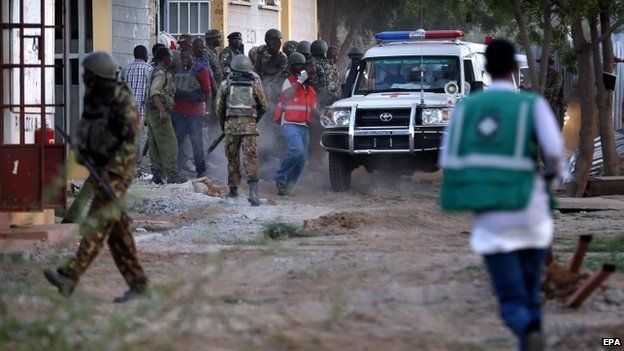 Troops and medics respond to the Garissa University attack. Image source
Troops and medics respond to the Garissa University attack. Image source
Al-Shabaab attack Kenyan troops stationed at a base in el-Ade in Southern Somalia. Somalia’s President Mohamud estimates the death toll to be 180 Kenyans, making this the deadliest attack since Kenyan operations in Somalia began in 2011.
2016
The ICC abandons the prosecution of William Ruto.